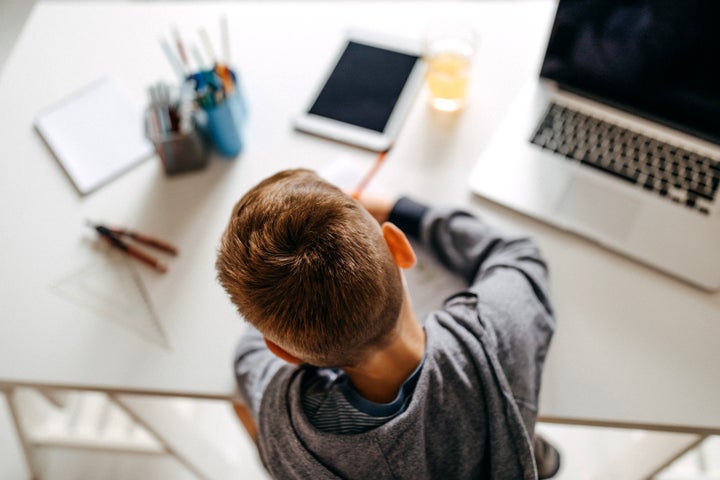“It just doesn’t work for us,” Christen Shepherd said, with exasperation, on a phone call with HuffPost Canada. Over the course of the 20-minute conversation, her voice dipped in and out of clarity, the sound glitching and going dead every few words, because of poor cellular service.
Shepherd was calling from her farmhouse “in the middle of nowhere” — which is to say just north of London, Ont., but not quite in Stratford — where her family has, since the beginning of quarantine, been engaged in an endless war against connectivity issues. “Sometimes,” she admitted, “it’s just impossible.”
What exactly is impossible is getting her three daughters to school — or at least, to online school. When COVID-19 shuttered schools globally in early April, forcing more than 300 million students worldwide to begin attending online classes, one widespread concern was thrown into sharp focus: what about those students in northern and rural communities who have poor (or no) internet access?
“My friends who live in the city are all doing much better than we are,” Shepherd said. “But for us, every day is a challenge. We miss important meetings and fall behind on schoolwork because our internet is so unreliable. We’ve had times when our connection stops working for half a day, or even an entire day at a time. It’s frustrating.”
Watch: Barack and Michelle Obama crash an online high school civics course. Story continues below.
The many struggles with e-learning
As it stands, the e-learning model presents a number of intractable problems: the barriers of adapting to a new learning environment, the pressures of time management and self-motivation, the already crushing anxieties of coping with a global pandemic.
Throwing a patchy internet connection into the mix only exacerbates an already nightmarish situation.
“Almost immediately, I knew it was going to be an issue,” Shepherd said. Her husband is a scientist who has been, like many others, working from home, and lately he’s been required to sign onto a number of video chat meetings. “What we’re finding is the internet is crashing all of the time, and so when he needs to be online, everyone else has to come off. Otherwise, nothing works.”
It’s an awkward balancing act between prioritizing the household work that generates income — in a time when so much of it has already been lost — and trying to facilitate an already precarious education situation.
“When, five minutes after we sit down to do schoolwork, the internet stops working, or my husband has to do a call, it gets really stressful,” Shepherd said. “It’s so easy to fall behind. But there’s nothing we can do about it.”

Some teachers, Shepherd said, have even started trying to check in with students every day to keep them motivated. “It’s a beautiful, fantastic thing for most kids,” she said, “but it’s a shame that we can’t have that, either.”
Brandy Rafeek, a mother of three kids from Barrie, Ont., has been saddled with a similar fate.
Rafeek’s two sons are doing online school, and even with the help of Rocket Hub — an “incredibly expensive” WiFi assistant device that plugs into the wall and works off nearby cell phone towers to boost speed and quality — only one person in the house can use the internet at a time. Otherwise, the connection collapses.
“Their teachers have been really great, and allow students to text them whenever they have questions,” said Rafeek. “And it’s not even like they’ve been overloaded with work. It should be manageable. But that isn’t always the case, because the internet sucks.”
On top of that, her youngest son has social anxiety, and she worries that being away from his friends at school might trigger a regression.
“It’s been really hard on him the last few weeks, being so isolated,” she said. “The thing is that his class has Zoom meetings sometimes, and he’s missed all of them because of the internet connection. When he signs on and gets a glimpse of all his friends there, and they start to call out to him and say hello, only for him to get kicked off, it adds a lot of stress.”

How virtual learning is affecting kids with IEPs
All three of Shepherd’s daughters have learning disabilities, and all three are on Individual Education Plans (IEPs). So is Rafeek’s eldest son. Ordinarily, this wouldn’t be an issue. It just means they’d get certain educational supports at school — say, a scribe to help with writing or a private room to complete work in.
The thing is that, when school goes digital, all of those supports are suddenly removed, and parents are left to figure out how to fill in the gaps.
Both Rafeek and Shepherd have stepped into that role for their kids. For Rafeek’s eldest son, things have been going fine. “It’s been fairly smooth,” she said. “He just needs longer for some assignments and tests, and will sometimes need one-on-one support. And his teachers have been lenient with timelines.”
But for Shepherd’s middle daughter, Samantha, who struggles to focus without an actual classroom to motivate her, things immediately became difficult.
“The regular classroom was challenging to begin with, and we had a flexible school staff that helped to modify her program so that she was having success,” Shepherd said. “But because of all these new conditions, by the second or third week, we were already falling seriously behind.”
Shepherd spoke with her daughter’s teachers and arranged an “experiential learning” model, which, so far, has been working. Rather than following pre-recorded lectures and doing assignments online, she’s pivoted to more hands-on life skills, like gardening, cooking, and measuring the perimeter of a fence the family recently put up.
If I were working full time, helping my kids with their schoolwork would be impossible.
Christen Shepherd
But there is no band-aid solution. Samantha also has reading delays, and watching videos of her teachers reciting lines from a novel doesn’t work very well for her. (Not to mention it takes forever to download videos on a bad WiFi connection.)
“I have to sit with her and read all of the assignments to her and explain questions when, typically, she would have someone at school to help her with that,” said Shepherd. “If I were working full time, it would be impossible.”
In fact, helping her kids with their schoolwork has been tough already. For the last few weeks, Shepherd has been battling pneumonia. She was in the emergency room prior to the quarantine, and she’s been sick throughout it. While she would have really benefited from time to rest and recuperate, all of her energy, she said, has gone to supporting her kids with their assignments.
Solutions on the way
All of this is uncharted territory. Nobody was expecting a global pandemic to impact families with kids in school for so long. Teachers are trying to make things easier for students, schools are trying to help out teachers, and provincial governments are working to make things easier for everyone. But a fast and effective solution doesn’t immediately present itself.
There have been attempts. Just last month, a school division in rural Manitoba went so far as to create a makeshift Wi-Fi hotspot by mounting an antenna on top of a school. People in the community could drive into the school’s bus loop and log onto the internet, since a number of kids in the area lacked access to the internet. They also loaned 5,500 laptops and tablets to students in homes lacking the resources.
And around that same time, the Ontario government announced it would be distributing iPads with free wireless data plans to students who might be struggling to access online learning tools.

But just last week, Ontario Education Minister Stephen Lecce encouraged teachers to “embrace” live video conferencing with students during the shutdown, announcing “synchronous learning” as the ideal educational model — not taking into account, of course, that this is less than ideal for families like Rafeek’s and Shepherd’s.
“I immediately panicked when he said that. It’s not going to work for us, because the internet would just crash all of the time” Shepherd said. “Samantha has already missed three Zoom meetings where the whole class is meant to connect with the teacher — twice because my husband needed the internet, and once because the internet just wasn’t cooperating. I worry she’ll start to feel left out of the class, or that the teacher will think we don’t care and are no longer engaged. But it’s not that. We just can’t log on.”
Rafeek says she knows the government is trying to find solutions, and that none of it is easy. But in the meantime, she says, parents are left to mediate their own confusion, with no definitive answers in sight.
“I have a lot of stress right now — about what’s going to happen for the month of June, about what’s going to happen for the next school term. We all do,” she said. “And if we could just get some answers, it would cut that stress in half. I realize there are a lot of moving parts with the solutions. I just hope they’re considering what families like ours are going through.”
Calling all HuffPost superfans!
Sign up for membership to become a founding member and help shape HuffPost’s next chapter
Credit: Source link